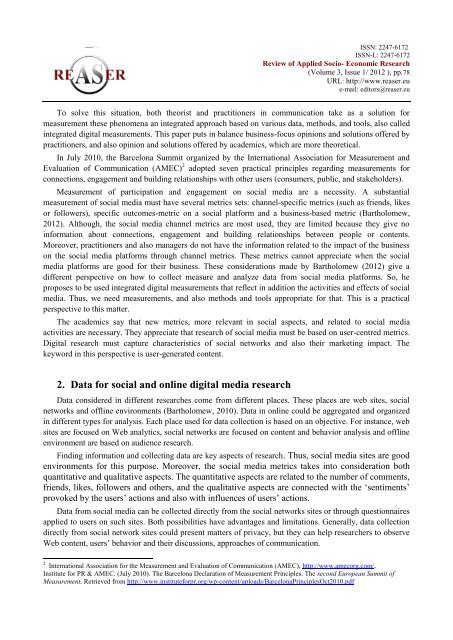Volume 3, ISSUE1/2012 - Review of Applied Socio-Economic ...
Volume 3, ISSUE1/2012 - Review of Applied Socio-Economic ...
Volume 3, ISSUE1/2012 - Review of Applied Socio-Economic ...
Create successful ePaper yourself
Turn your PDF publications into a flip-book with our unique Google optimized e-Paper software.
ISSN: 2247-6172<br />
ISSN-L: 2247-6172<br />
<strong>Review</strong> <strong>of</strong> <strong>Applied</strong> <strong>Socio</strong>- <strong>Economic</strong> Research<br />
(<strong>Volume</strong> 3, Issue 1/ <strong>2012</strong> ), pp.78<br />
URL: http://www.reaser.eu<br />
e-mail: editors@reaser.eu<br />
To solve this situation, both theorist and practitioners in communication take as a solution for<br />
measurement these phenomena an integrated approach based on various data, methods, and tools, also called<br />
integrated digital measurements. This paper puts in balance business-focus opinions and solutions <strong>of</strong>fered by<br />
practitioners, and also opinion and solutions <strong>of</strong>fered by academics, which are more theoretical.<br />
In July 2010, the Barcelona Summit organized by the International Association for Measurement and<br />
Evaluation <strong>of</strong> Communication (AMEC) 2 adopted seven practical principles regarding measurements for<br />
connections, engagement and building relationships with other users (consumers, public, and stakeholders).<br />
Measurement <strong>of</strong> participation and engagement on social media are a necessity. A substantial<br />
measurement <strong>of</strong> social media must have several metrics sets: channel-specific metrics (such as friends, likes<br />
or followers), specific outcomes-metric on a social platform and a business-based metric (Bartholomew,<br />
<strong>2012</strong>). Although, the social media channel metrics are most used, they are limited because they give no<br />
information about connections, engagement and building relationships between people or contents.<br />
Moreover, practitioners and also managers do not have the information related to the impact <strong>of</strong> the business<br />
on the social media platforms through channel metrics. These metrics cannot appreciate when the social<br />
media platforms are good for their business. These considerations made by Bartholomew (<strong>2012</strong>) give a<br />
different perspective on how to collect measure and analyze data from social media platforms. So, he<br />
proposes to be used integrated digital measurements that reflect in addition the activities and effects <strong>of</strong> social<br />
media. Thus, we need measurements, and also methods and tools appropriate for that. This is a practical<br />
perspective to this matter.<br />
The academics say that new metrics, more relevant in social aspects, and related to social media<br />
activities are necessary. They appreciate that research <strong>of</strong> social media must be based on user-centred metrics.<br />
Digital research must capture characteristics <strong>of</strong> social networks and also their marketing impact. The<br />
keyword in this perspective is user-generated content.<br />
2. Data for social and online digital media research<br />
Data considered in different researches come from different places. These places are web sites, social<br />
networks and <strong>of</strong>fline environments (Bartholomew, 2010). Data in online could be aggregated and organized<br />
in different types for analysis. Each place used for data collection is based on an objective. For instance, web<br />
sites are focused on Web analytics, social networks are focused on content and behavior analysis and <strong>of</strong>fline<br />
environment are based on audience research.<br />
Finding information and collecting data are key aspects <strong>of</strong> research. Thus, social media sites are good<br />
environments for this purpose. Moreover, the social media metrics takes into consideration both<br />
quantitative and qualitative aspects. The quantitative aspects are related to the number <strong>of</strong> comments,<br />
friends, likes, followers and others, and the qualitative aspects are connected with the ‘sentiments’<br />
provoked by the users’ actions and also with influences <strong>of</strong> users’ actions.<br />
Data from social media can be collected directly from the social networks sites or through questionnaires<br />
applied to users on such sites. Both possibilities have advantages and limitations. Generally, data collection<br />
directly from social network sites could present matters <strong>of</strong> privacy, but they can help researchers to observe<br />
Web content, users’ behavior and their discussions, approaches <strong>of</strong> communication.<br />
2 International Association for the Measurement and Evaluation <strong>of</strong> Communication (AMEC), http://www.amecorg.com/,<br />
Institute for PR & AMEC. (July 2010). The Barcelona Declaration <strong>of</strong> Measurement Principles. The second European Summit <strong>of</strong><br />
Measurement. Retrieved from http://www.instituteforpr.org/wp-content/uploads/BarcelonaPrinciplesOct2010.pdf








